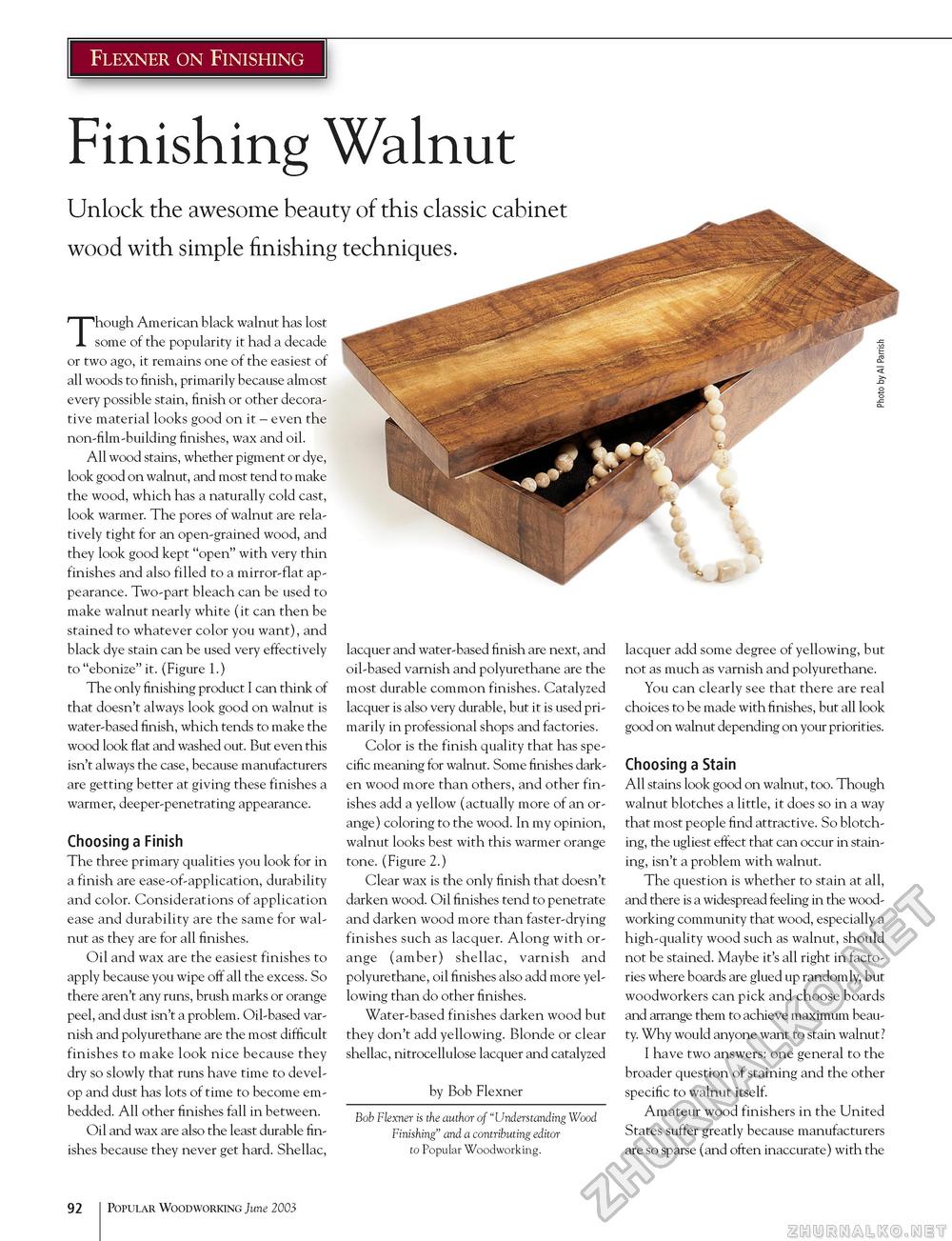Popular Woodworking 2003-06 № 134, страница 94
Flexner on Finishing Finishing Walnut Unlock the awesome beauty of this classic cabinet wood with simple finishing techniques. Though American black walnut has lost some of the popularity it had a decade or two ago, it remains one of the easiest of all woods to finish, primarily because almost every possible stain, finish or other decorative material looks good on it - even the non-film-building finishes, wax and oil. All wood stains, whether pigment or dye, look good on walnut, and most tend to make the wood, which has a naturally cold cast, look warmer. The pores of walnut are relatively tight for an open-grained wood, and they look good kept "open" with very thin finishes and also filled to a mirror-flat appearance. Two-part bleach can be used to make walnut nearly white (it can then be stained to whatever color you want), and black dye stain can be used very effectively to "ebonize" it. (Figure 1.) The only finishing product I can think of that doesn't always look good on walnut is water-based finish, which tends to make the wood look flat and washed out. But even this isn't always the case, because manufacturers are getting better at giving these finishes a warmer, deeper-penetrating appearance. Choosing a Finish The three primary qualities you look for in a finish are ease-of-application, durability and color. Considerations of application ease and durability are the same for walnut as they are for all finishes. Oil and wax are the easiest finishes to apply because you wipe off all the excess. So there aren't any runs, brush marks or orange peel, and dust isn't a problem. Oil-based varnish and polyurethane are the most difficult finishes to make look nice because they dry so slowly that runs have time to develop and dust has lots of time to become embedded. All other finishes fall in between. Oil and wax are also the least durable finishes because they never get hard. Shellac, lacquer and water-based finish are next, and oil-based varnish and polyurethane are the most durable common finishes. Catalyzed lacquer is also very durable, but it is used primarily in professional shops and factories. Color is the finish quality that has specific meaning for walnut. Some finishes darken wood more than others, and other finishes add a yellow (actually more of an orange) coloring to the wood. In my opinion, walnut looks best with this warmer orange tone. (Figure 2.) Clear wax is the only finish that doesn't darken wood. Oil finishes tend to penetrate and darken wood more than faster-drying finishes such as lacquer. Along with orange (amber) shellac, varnish and polyurethane, oil finishes also add more yellowing than do other finishes. Water-based finishes darken wood but they don't add yellowing. Blonde or clear shellac, nitrocellulose lacquer and catalyzed by Bob Flexner Bob Flexner is the author of "Understanding Wood Finishing" and a contributing editor to Popular Woodworking. lacquer add some degree of yellowing, but not as much as varnish and polyurethane. You can clearly see that there are real choices to be made with finishes, but all look good on walnut depending on your priorities. Choosing a Stain All stains look good on walnut, too. Though walnut blotches a little, it does so in a way that most people find attractive. So blotching, the ugliest effect that can occur in staining, isn't a problem with walnut. The question is whether to stain at all, and there is a widespread feeling in the woodworking community that wood, especially a high-quality wood such as walnut, should not be stained. Maybe it's all right in factories where boards are glued up randomly, but woodworkers can pick and choose boards and arrange them to achieve maximum beauty. Why would anyone want to stain walnut? I have two answers: one general to the broader question of staining and the other specific to walnut itself. Amateur wood finishers in the United States suffer greatly because manufacturers are so sparse (and often inaccurate) with the 92 Popular Woodworking June 2003 |








